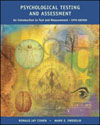 |
1 |  | 
Compare and contrast CAPA and CATI. Discuss the advantages and limitations of CATI. |
|  | |
 |
 |
2 |  | 
What are the advantages and disadvantages of CAPA? What concerns have been raised concerning the practice? |
|  | |
 |
 |
3 |  | 
What are ways in which computer-adaptive testing can enhance the reliability and validity of test results? |
|  | |
 |
 |
4 |  | 
Discuss the various uses of item-branching technology. Encourage students to think of their experience with commonly administered tests (e.g., GRE, ACT, U.S. Constitution test, driver's license test, visual and hearing acuity tests) and how this technology could be helpful in the development and administration of these tests. |
|  | |
 |
 |
5 |  | 
Discuss the "confession/computer hypothesis." Ask students to comment on whether or not they would be more inclined to reveal personal information to a computer as compared to a "live" clinician. |
|  | |
 |
 |
6 |  | 
The authors point out in Chapter 17 that currently no government regulations exists for CAPA-related publishing or traditional psychological test publishing. Do your students believe that government regulations should be developed to control the CAPA-related publishing and/or traditional psychological test publishing? |
|  | |
 |
 |
7 |  | 
Who should be allowed access to CAPA-related products? |
|  | |
 |
 |
8 |  | 
Are the SAT and GRE considered computer-assisted? Why or why not? Have students discuss if they have had experience taking the SAT or GRE by computer. |
|  | |
 |
 |
9 |  | 
Comment on whether or not you (the instructor) have developed an "item bank" for this course. Why or why not? |
|  | |
 |
 |
10 |  | 
Can scores on a conventionally administered test be considered equivalent to scores on a computer-assisted administration of the same test? Why or why not? Consider areas such as effects of item type, item content, and the test takers' attitudes and emotional reactions. |
|  | |
 |
 |
11 |  | 
Relating to inputting of tests, compare and contrast central processing, teleprocessing, and local processing. Review the advantages and limitations of each. |
|  | |
 |
 |
12 |  | 
Referring to the information presented in the chapter's Everyday Psychometrics entry on Types of Computer-Generated Psychological Reports, compare and contrast simple versus extended scoring, descriptive, screening, and consultative reports. Bring in examples to illustrate each (see demonstration #1). |
|  | |
 |
 |
13 |  | 
Review the suggested questions to be raised when a psychologist is considering the use of a computer-administered version of a conventional test. Direct the students' attention to Table 19-1. |
|  | |
 |
 |
14 |  | 
Discuss the relationship between the Barnum effect and the validity of CAPA personality inventories. |
|  | |
 |
 |
15 |  | 
Based on the experiences your students have had with computer-administered and paper-and-pencil versions of tests, discuss the issue of equivalence. How do their impressions of the equivalence of the two methods of test administration based on their experiences compare to the findings of research presented in the chapter? Discuss the limitations of the research presented in the chapter and implications for using one method of test administration versus the other. |
|  | |
 |
 |
16 |  | 
Discuss why the text authors characterize the validity of "computer-based test interpretation programs as "not encouraging." Discuss the various approaches to determining validity of these programs including their advantages and limitations. What are the most appropriate criteria to determine the criterion-validity of computer-based test interpretation programs? |
|  | |
 |
 |
17 |  | 
Discuss the similarities and differences in the concepts of actuarial assessment, actuarial prediction, clinical prediction, mechanical prediction, and computerized assessment. Discuss the various alternatives that can determine interpretive output of a computer-based test interpretation? |
|  | |
 |
 |
18 |  | 
Ask your students to assume the role of a clinical, counseling, or school psychologist. Based on their reading of this chapter, discuss their preferences for conducting psychological assessments with or without the benefit of computer software. As a professional psychologist, in what ways (if any) would they use CAPA? |
|  | |
 |
 |
19 |  | 
Based on your students' reading of this chapter, discuss what future they perceive for CAPA. Discuss separately the use of computers for scoring protocols and organizing data; and for interpreting data and printing out psychological reports. Have them support their opinions with information from the chapter. |
|  | |
 |
 |
20 |  | 
Ask class members to discuss their preferences for a computer-administered clinical interview versus a face-to-face interview. |
|  | |
 |



 2002 McGraw-Hill Higher Education
2002 McGraw-Hill Higher Education